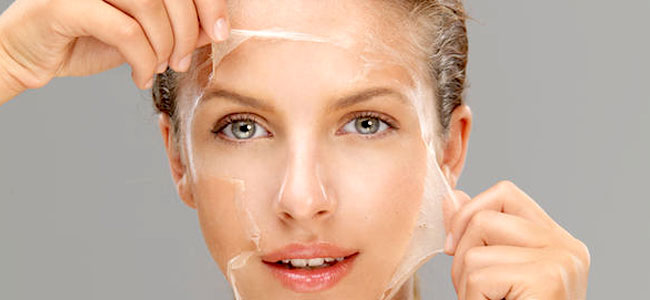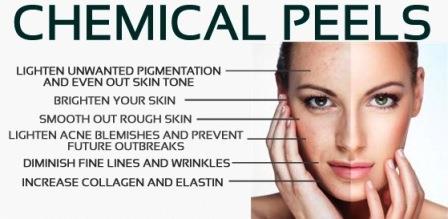The desire for soft and supple skin in general and face in particular has been known since the ancient civilizations. Queens like Cleopatra and Nefertiti used to bathe in sour milk and rubbed their skins with fermented grape skins to soften their skin. The natural process of skin renewal tends to change and slow down with age giving the skin a tired and gray look with decreased elasticity. Chemical peels helps to remove the old skin cells by a process called exfoliation and thus stimulates the regeneration of new ones making the skin look brighter, healthier and more beautiful.

About the procedure
Today we have a wide range of organic acids (Salicylic acid, Lactic acid, Mandelic acid, Glycolic acid, TCA) for chemical peels and we use them to treat and improve various skin conditions. Some of the indications include acne and acne scars, rosacea, solar keratosis, wrinkles and sun damage of skin and chest. Chemical peels depend on the indications, the skin type and the nature of the agent used itself. Usually chemical peels are carried out once every 2-4 weeks for a few sessions depending on the indications.
Since the improvement of the skin is gradual, refreshment of the skin is readily visible, and appears to be completely natural. The effects of peeling is long-lasting because it stimulates the renewal of Collagen and Elastin in the skin.
‘Depth’ of peel and indications
Superficial peels are the mildest types of chemical peels and can be used on all skin types. A mild or dilute acid (mostly Glycolic acid) is used for superficial peels. This type of peel is indicated for acne scars, mild photodamage, to improve pigmentation changes in the skin, and fine wrinkles in all skin types. Superficial peels are also called as LUNCHTIME PEELS.
Medium peels penetrate the skin more deeply than superficial peels and cause a second-degree burn of the skin. TCA (Trichloroacetic acid) is most commonly used although higher concentrations of milder acids like Glycolic acid can be used to achieve the medium peel. Medium peels target mild to moderate wrinkles, long-term sun damage, pigment changes, and precancerous lesions of the skin.
Deep peels penetrate several layers of the skin and is only used on the face. Phenol is the agent generally used and it is usually avoided in darker skin types due to the fear of scarring and hyperpigmentation. Deep peels are used to treat deep wrinkles, long-term sun damage, pronounced pigmentary changes and lesions and growths on the skin.
Am I a candidate?
A chemical peel will not be done if you have:
- Recently used Isotretinoin (a drug used to treat acne).
- Had facial surgery or facial radiation therapy.
- Active Herpes infection in the area to be treated.
- An impaired immune system.
- Known allergies to certain medications.

Preparation of the skin
For an effective result I will suggest ‘conditioning’ or preparing the skin for at least 2 weeks before the actual peel procedure. This will involve cleansing the skin twice a day, applying a special moisturizer or cream once or twice a day, and using sunscreen every day. If you have had a history of cold sores in the lips or around the mouth area I might consider a few days prophylactic treatment with an antiviral agent.
During the procedure
Right before the procedure I will clean the skin with a cleanser. The peeling agent is applied with a small fan brush in an even layer all over the area being treated and left for a few minutes. The peel is then ‘neutralized’ with special agents or water. There might be some transient burning or itching which will eventually decrease. The depth of the peel is increased by leaving on the agent for longer time or by using stronger agents depending on the conditions being treated. The entire procedure might take 60-90 minutes depending on how large an area is being treated.
Recovery time
In general deeper the peel, greater the recovery time and side effects. Chemical peels can result in:
- Redness (erythema) – redness can last from few days to weeks depending on the depth of the peel.
- Pigmentation.
- Crusting and scaling.
- Swelling.
- Scarring.
- Infections.
- Increased photosensitivity.
Post peel care
Following the peel make sure you follow all the instructions outlined by me. Keep the peeled areas cool. You will need to cleanse the skin with water or a special cleanser, moisturize the skin daily (for non-oily skins) and use sunscreens generously. Do not pick or peel any scabs or crusts as this leads to scarring.
Package
Considering the fact that peels may need to be repeated once every 2-4 weeks and also the fact that every condition is different and every patient is different it is best if we discuss your needs and tailor an appropriate package. The costs will include consultations, the cost of the chemicals, the pre-peel regimen and the actual peel process.
